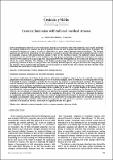Por favor, use este identificador para citar o enlazar a este item:
http://hdl.handle.net/10261/36666COMPARTIR / EXPORTAR:
 SHARE
BASE SHARE
BASE
|
|
| Visualizar otros formatos: MARC | Dublin Core | RDF | ORE | MODS | METS | DIDL | DATACITE | |

| Campo DC | Valor | Lengua/Idioma |
|---|---|---|
| dc.contributor.author | Sanchez-Herencia, A. Javier | - |
| dc.contributor.author | Baudín de la Lastra, Carmen | - |
| dc.date.accessioned | 2011-06-09T09:18:27Z | - |
| dc.date.available | 2011-06-09T09:18:27Z | - |
| dc.date.issued | 2009 | - |
| dc.identifier.citation | Bol. Soc. Esp. Ceram. V. 48, 6, 311-320 (2009) | es_ES |
| dc.identifier.issn | 0366-3175 | - |
| dc.identifier.uri | http://hdl.handle.net/10261/36666 | - |
| dc.description.abstract | Severe environments imposed by new technologies demand new materials with better properties and ensured reliability. The intrinsic brittleness of ceramics has forced scientists to look for new materials and processing routes to improve the mechanical behaviour of ceramics in order to allow their use under severe thermomechanical conditions. The laminate approach has allowed the fabrication of a new family of composite materials with strength and reliability superior to those of monolithic ceramics with microstructures similar to those of the constituent layers. The different ceramic laminates developed since the middle 1970´s can be divided in two large groups depending on whether the development of residual stresses between layers is the main design tool. This paper reviews the developments in the control and tailoring of residual stresses in ceramic laminates. The tailoring of the thickness and location of layers in compression can lead to extremely performing structures in terms of strength values and reliability. External layers in compression lead to the strengthening of the structure. When relatively thin and highly compressed layers are located inside the material, threshold strength, crack bifurcation and crack arrest during fracture occur. | es_ES |
| dc.language.iso | eng | es_ES |
| dc.publisher | Sociedad Española de Cerámica y Vidrio | es_ES |
| dc.rights | openAccess | es_ES |
| dc.subject | Ceramic laminates | es_ES |
| dc.subject | Fracture | es_ES |
| dc.title | Ceramic laminates with tailored residual stresses | es_ES |
| dc.type | artículo | es_ES |
| dc.description.peerreviewed | Peer reviewed | es_ES |
| dc.relation.publisherversion | http://boletines.secv.es/upload/20100113170304.200948311.pdf | es_ES |
| dc.type.coar | http://purl.org/coar/resource_type/c_6501 | es_ES |
| item.openairetype | artículo | - |
| item.grantfulltext | open | - |
| item.cerifentitytype | Publications | - |
| item.openairecristype | http://purl.org/coar/resource_type/c_18cf | - |
| item.fulltext | With Fulltext | - |
| item.languageiso639-1 | en | - |
| Aparece en las colecciones: | (ICV) Artículos | |
Ficheros en este ítem:
| Fichero | Descripción | Tamaño | Formato | |
|---|---|---|---|---|
| BSECV-2011-junio-8.pdf | 943,3 kB | Adobe PDF |  Visualizar/Abrir |
CORE Recommender
Page view(s)
327
checked on 19-abr-2024
Download(s)
151
checked on 19-abr-2024
Google ScholarTM
Check
NOTA: Los ítems de Digital.CSIC están protegidos por copyright, con todos los derechos reservados, a menos que se indique lo contrario.
